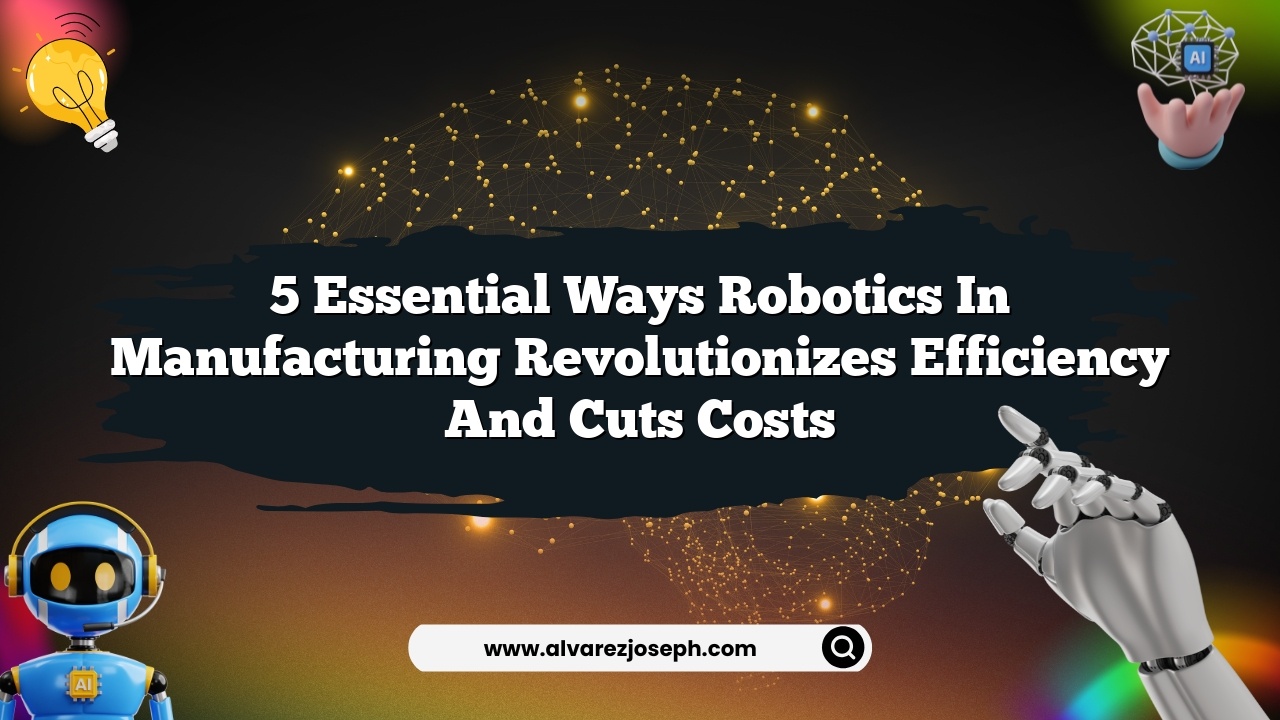Imagine for a moment a world where factories hum like well-tuned orchestras, machines work tirelessly without breaks, and production lines operate seamlessly, all while significantly slashing costs. This is not some futuristic fantasy, but rather the current landscape of manufacturing, revolutionized by the advent of robotics. If you’re curious about how robotics in manufacturing is reshaping industries, increasing efficiency, and cutting costs, you’re in for a treat. Let’s dive into five essential ways that robotics is transforming the manufacturing sector.
Streamlining Production Lines with Automation
One of the most immediate benefits of incorporating robotics into manufacturing is the automation of production lines. Traditional manufacturing processes often involve repetitive tasks that can not only slow down production but also lead to human error. When robots take over these monotonous jobs, efficiency skyrockets.
Imagine a scenario where a robotic arm is tasked with assembling widgets. This machine can work continuously, without the need for lunch breaks or coffee runs, and with precision that outstrips human capabilities. According to a study by the International Federation of Robotics, companies that have adopted automation reported a 25% increase in productivity. That’s like getting a bonus you didn’t even have to ask for!
But this isn’t just about speed. Robotics can significantly enhance quality control as well. Robots equipped with advanced sensors can detect inconsistencies in products that a human eye might miss. This not only ensures higher quality products but also leads to less waste and lower costs. Who wouldn’t want to save money by reducing the number of defective items?
Enhanced Safety and Reduced Labor Costs
Let’s be honest: manufacturing can be dangerous. Heavy machinery, toxic materials, and the risk of accidents make it a challenging environment for workers. Here’s where robotics swoop in like superheroes. By taking over hazardous tasks, robots dramatically reduce workplace accidents. This not only keeps employees safe but also cuts costs related to workers’ compensation and insurance.
Consider this: in a factory where robots handle the heavy lifting and dangerous tasks, the risk for human workers diminishes. Consequently, the company might even enjoy lower insurance premiums. A study from the U.S. Bureau of Labor Statistics indicates that industries that have integrated robotics have seen a 40% decrease in workplace accidents. Talk about a win-win situation!
Additionally, with robots doing the grunt work, manufacturers can reallocate human resources to more strategic roles. Instead of having employees perform repetitive tasks, they can focus on innovation, problem-solving, and customer service. This shift not only enhances job satisfaction but could also lead to higher employee retention rates. Who wouldn’t prefer working on exciting projects instead of assembling parts all day?
Flexible Manufacturing with Adaptive Robotics
Gone are the days of rigid production lines! Thanks to advancements in robotics technology, manufacturers can now enjoy incredible flexibility. Modern robots can be programmed to perform multiple tasks and can easily switch between different products. This adaptability is crucial in today’s market, where customer preferences change rapidly.
Imagine a factory that produces smart devices. Instead of dedicating an entire production line to one type of device, adaptive robots can switch from assembling smartphones to tablets with just a few clicks. This flexibility not only caters to current market demands but also reduces inventory costs. By minimizing overproduction and ensuring that only what is needed is made, manufacturers can optimize their resources.
Moreover, robotics enables companies to implement just-in-time manufacturing, reducing the need for extensive warehousing and allowing for faster response to market changes. This agility in production is essential for staying competitive in an ever-evolving landscape. But how does this relate to your daily life? Well, consider the impact of having the latest gadgets available at the blink of an eye!
Data-Driven Insights for Continuous Improvement
Another incredible advantage of robotics in manufacturing is the wealth of data generated by these machines. Today’s robots come equipped with sensors and connectivity features that allow them to collect vast amounts of information about their performance and the products they create. This data can be analyzed to identify inefficiencies, predict maintenance needs, and optimize production processes.
Imagine a robot that not only assembles cars but also tracks how quickly it completes each task and the amount of energy it consumes. By analyzing this data, manufacturers can make informed decisions to improve performance and reduce costs. The possibilities are endless! For instance, predictive maintenance can prevent costly breakdowns, ensuring that production remains uninterrupted and profits continue to flow.
Real-time data also enhances decision-making. Managers can monitor production lines remotely, adjusting processes on-the-fly based on current performance metrics. This level of oversight was unimaginable a few decades ago, but today it’s the norm. With the ability to make swift adjustments, organizations can boost their competitiveness and efficiency.
Sustainable Manufacturing Practices
Let’s not overlook the environmental impact of robotics in manufacturing. As companies strive to become more sustainable, robotics plays a pivotal role. Automated processes often lead to reduced energy consumption and waste generation. Robots can work tirelessly to maximize efficiency, optimizing the use of raw materials and minimizing excess.
Consider a manufacturing plant that integrates robotics into its processes. By optimizing the energy usage of machines, the plant can significantly lower its carbon footprint. Not only does this appeal to environmentally-conscious consumers, but it can also lead to significant cost savings on energy bills.
Furthermore, many robotic systems are designed to use less material while maintaining product quality. This balance not only conserves resources but also lowers costs associated with raw materials. In a world where sustainability is becoming increasingly crucial, integrating robotics can set manufacturers apart as industry leaders.
Quick Summary
- Streamlined Production: Robotics automates tedious tasks, boosting productivity by 25%.
- Enhanced Safety: Reduces workplace accidents by 40%, lowering insurance costs.
- Flexible Manufacturing: Adaptive robots can switch tasks based on market demands, reducing inventory costs.
- Data-Driven Insights: Collects real-time data to improve decision-making and predict maintenance needs.
- Sustainable Practices: Minimizes energy consumption and waste, appealing to eco-conscious consumers.
Frequently Asked Questions
How do robotics improve efficiency in manufacturing?
Robotics enhances efficiency by automating repetitive tasks, reducing human error, and allowing for real-time data analysis.
What are the safety benefits of using robots in manufacturing?
Robots take over hazardous tasks, reducing the risk of workplace accidents and lowering associated costs such as insurance and compensation.
Can robots adapt to different manufacturing tasks?
Yes, modern robotics are designed to be flexible and can quickly switch between various tasks, catering to changing market needs.
How does data collected from robots influence manufacturing?
Data provides insights into machine performance, enabling predictive maintenance and optimized production processes to enhance overall efficiency.
Are there environmental benefits to using robotics?
Absolutely! Robotics can lead to reduced energy consumption and waste generation, supporting sustainable manufacturing practices.
What is the future of robotics in manufacturing?
The future is bright! As technology advances, we can expect even more intelligent, adaptable, and efficient robotic systems to emerge, revolutionizing the industry further.
In conclusion, the integration of robotics in manufacturing isn’t just a trend; it’s a revolution. As companies harness the power of automation, they’re not only increasing efficiency and cutting costs but also paving the way for a more sustainable and innovative future. So, are you ready to embrace the robotic revolution? It’s certainly an exciting time to be in manufacturing!












